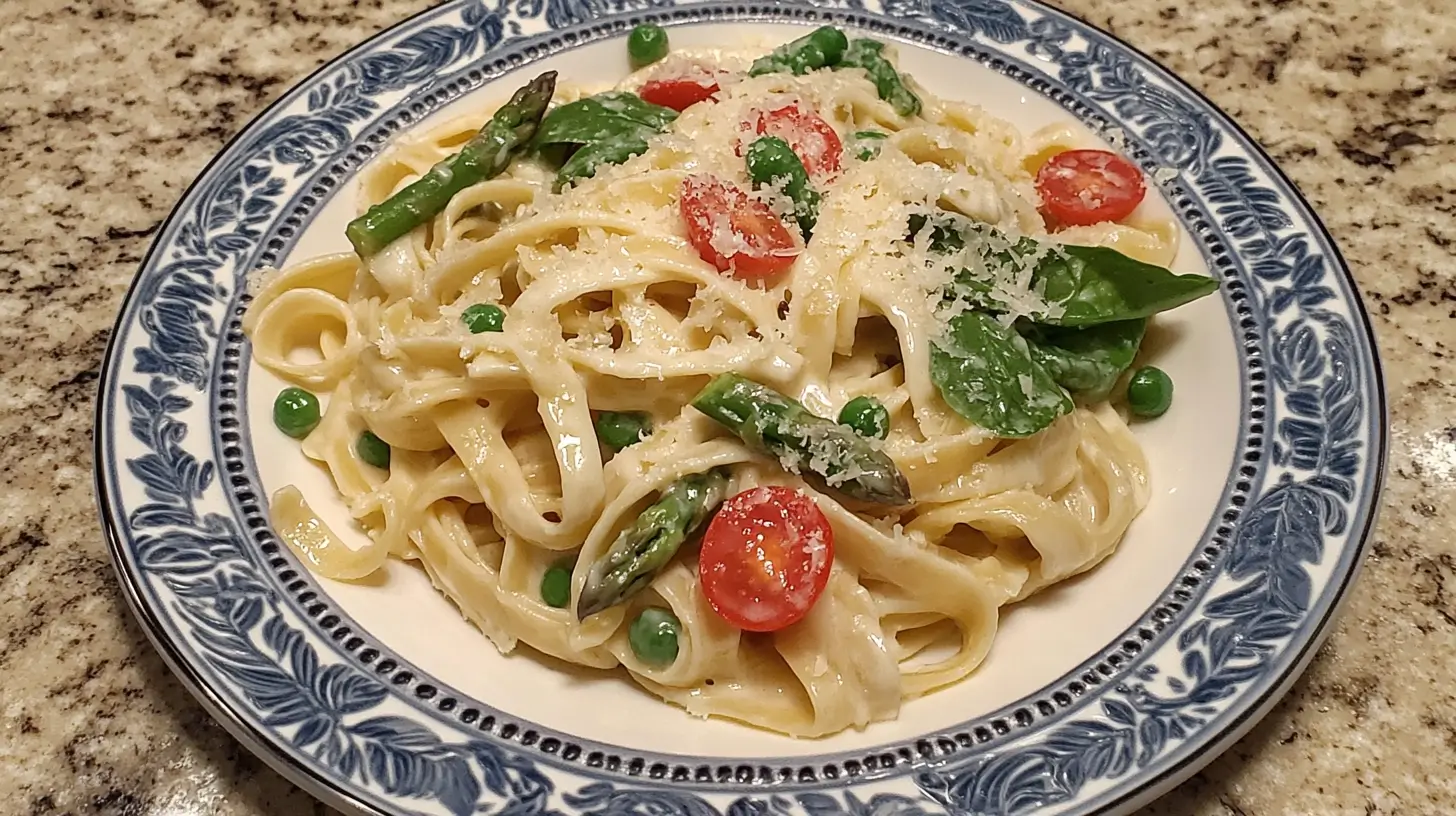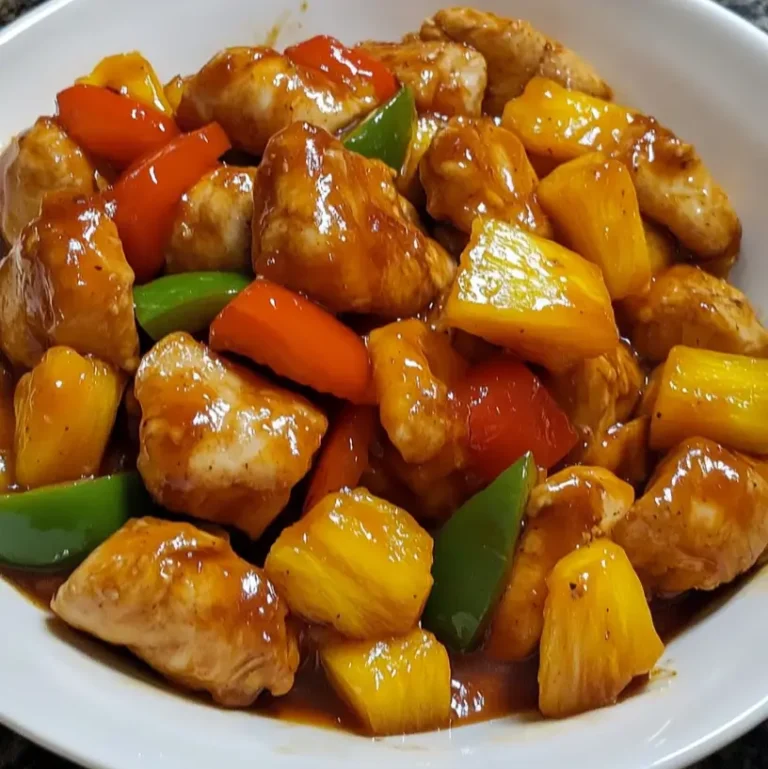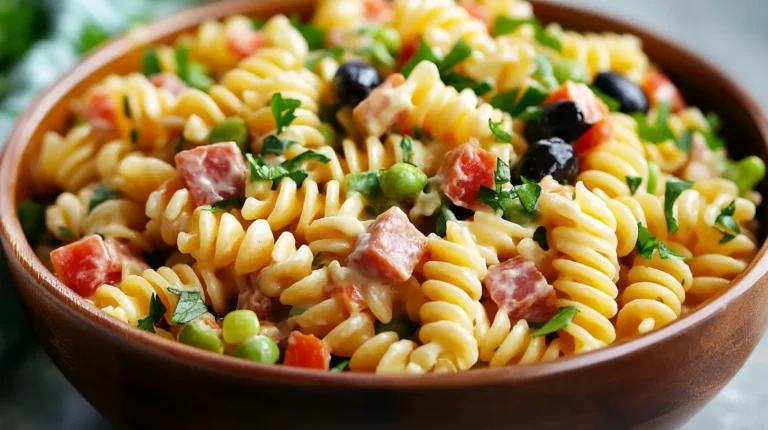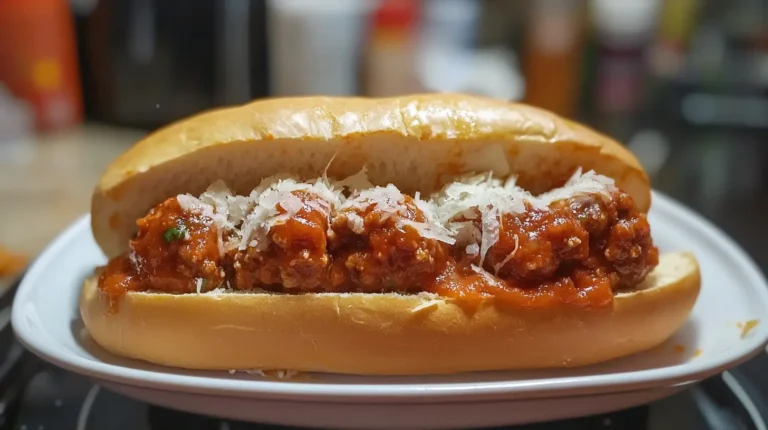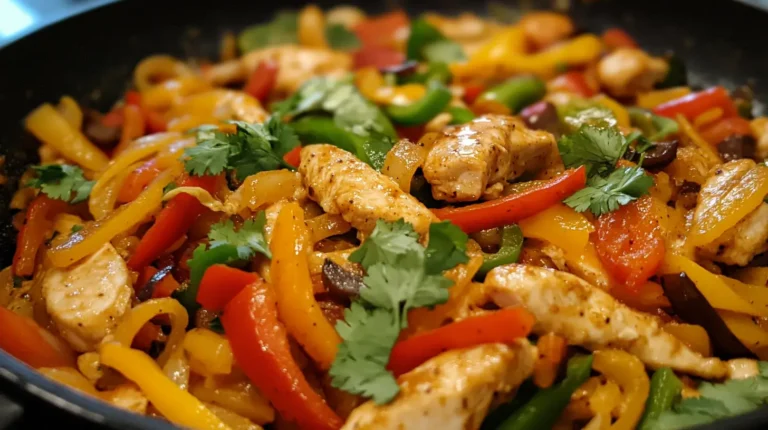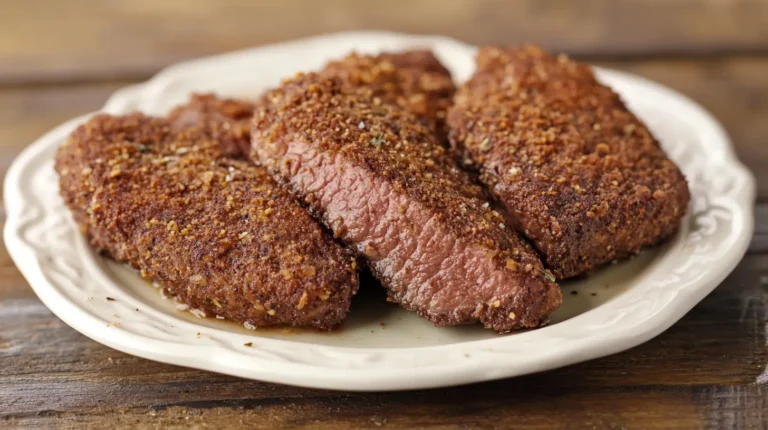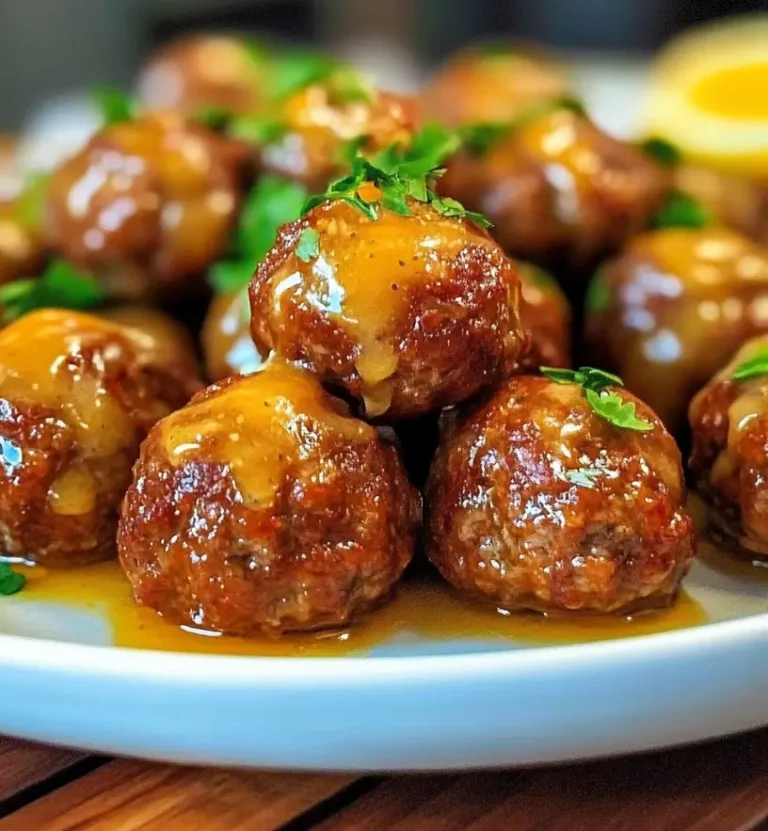Spring Vegetable Fettuccine Alfredo in 6 Easy Steps
Spring Vegetable Fettuccine Alfredo is the ultimate celebration of spring’s bounty – a luxurious pasta dish that combines silky homemade Alfredo sauce with the season’s freshest produce. This recipe transforms simple ingredients into an extraordinary meal that’s perfect for both weeknight dinners and special occasions. The combination of tender fettuccine, rich cream sauce, and vibrant vegetables creates a dish that’s as beautiful as it is delicious.
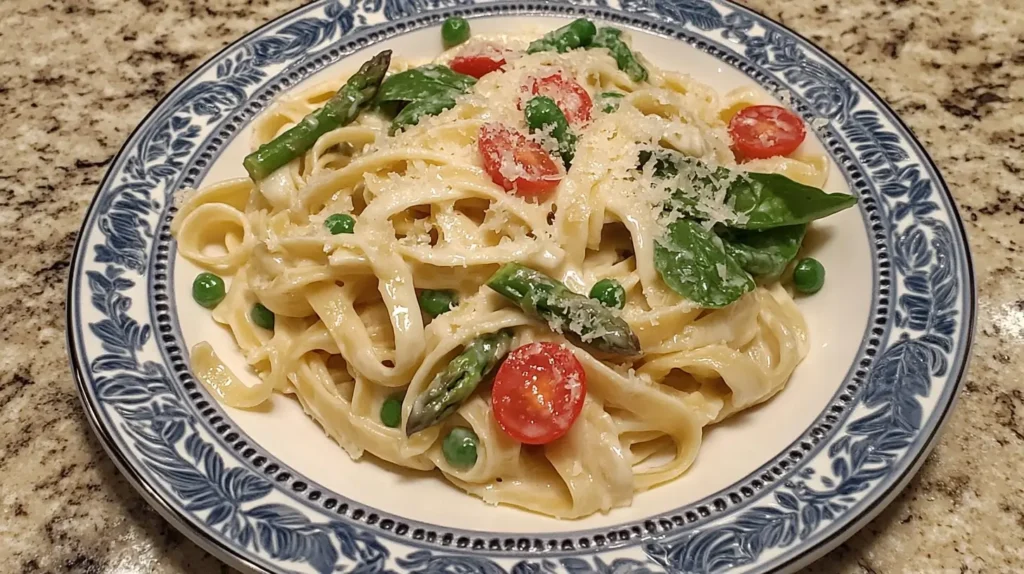
Table of Contents
The Perfect Spring Pasta: Why This Recipe Stands Out
When spring arrives, our palates naturally crave lighter, brighter flavors after the heavy comfort foods of winter. This Spring Vegetable Fettuccine Alfredo strikes the perfect balance – it maintains the indulgent creaminess we love about classic Alfredo while incorporating the fresh, crisp textures of seasonal vegetables. The result is a dish that feels both comforting and refreshing.
The magic of this recipe lies in its versatility. While we’re using classic spring vegetables like asparagus and peas, you can easily adapt it based on what’s available at your local market or in your garden. This flexibility makes it an excellent recipe to have in your repertoire throughout the spring months.
A Brief History of Fettuccine Alfredo
Understanding the origins of Fettuccine Alfredo adds depth to your cooking experience. The dish was created in 1914 by Alfredo di Lelio at his restaurant in Rome. His original version was remarkably simple – just fresh fettuccine tossed with butter and Parmigiano-Reggiano cheese. The creamy version we know today, with heavy cream, evolved in America.
Interestingly, the dish gained international fame when two Hollywood stars discovered it during their honeymoon in Rome in the 1920s. They loved it so much they brought the recipe back to America, where it was adapted to suit local tastes. Today, we’re putting a seasonal spin on this classic by incorporating spring’s best vegetables.
Selecting the Best Spring Vegetables
The success of this dish depends heavily on using the freshest seasonal produce. Here’s what to look for when selecting your vegetables:
- Asparagus: Choose firm, bright green stalks with tightly closed tips
- Peas: Fresh peas should be bright green and firm; frozen work well too
- Spinach: Look for crisp, dark green leaves without yellowing
- Cherry tomatoes: Select plump, fragrant tomatoes with smooth skin
- Zucchini: Small to medium zucchinis have the best flavor and texture
When possible, buy organic and locally sourced vegetables – they’ll have superior flavor and nutritional value. Farmers’ markets are excellent places to find the freshest spring produce.
Ingredients for Spring Vegetable Fettuccine Alfredo
Pasta & Vegetables
- 12 oz (340g) fettuccine pasta – the foundation of the dish
- 1½ cups (225g) asparagus, trimmed and cut into 1-inch pieces
- ¾ cup (110g) fresh peas (or frozen, thawed)
- 3 cups (90g) baby spinach – packed
- 1 cup (150g) cherry tomatoes, halved
- 1 medium zucchini, sliced into half-moons (optional)
Alfredo Sauce
- 4 tbsp (60g) unsalted butter – for richness
- 1½ cups (360ml) heavy cream – the base of our sauce
- 4 garlic cloves, minced – for aromatic depth
- 1½ cups (150g) freshly grated Parmesan cheese – plus extra for serving
- ¾ tsp salt, or to taste
- ½ tsp black pepper, freshly ground
- ⅛ tsp nutmeg (optional) – adds warmth
Garnishes & Extras
- ¼ cup fresh basil or parsley, chopped
- 1 tsp lemon zest (optional) – brightens the dish
- Red pepper flakes – for those who like heat
Step-by-Step Cooking Instructions
1. Preparing the Vegetables
Proper vegetable preparation ensures they maintain their texture and bright colors:
- Blanching asparagus and peas:
- Bring a pot of salted water to boil
- Prepare an ice bath (bowl of ice water)
- Blanch asparagus for 90 seconds, peas for 60 seconds
- Immediately transfer to ice bath to stop cooking
- Drain and pat dry
- Preparing other vegetables:
- Wash and halve cherry tomatoes
- Slice zucchini if using
- Rinse and dry spinach
2. Cooking the Pasta
Achieving perfectly cooked pasta is crucial:
- Use a large pot with plenty of salted water (it should taste like the sea)
- Cook fettuccine according to package instructions, aiming for al dente
- Reserve 1 cup (240ml) pasta water before draining
- Drain pasta but do not rinse (the starch helps sauce adhere)
3. Making the Alfredo Sauce
This is where the magic happens:
- Melt butter in a large skillet over medium heat
- Add minced garlic and sauté for 30 seconds until fragrant but not browned
- Pour in heavy cream, stirring constantly
- Bring to a gentle simmer (do not boil vigorously)
- Gradually whisk in Parmesan cheese until fully melted and smooth
- Season with salt, pepper, and optional nutmeg
- If sauce seems too thick, thin with reserved pasta water 1 tbsp at a time
4. Combining All Components
The final assembly:
- Add drained pasta to the sauce, tossing to coat thoroughly
- Gently fold in blanched asparagus and peas
- Add spinach and cherry tomatoes, tossing just until spinach wilts
- If using zucchini, sauté briefly before adding
- Adjust consistency with more pasta water if needed
- Taste and adjust seasoning
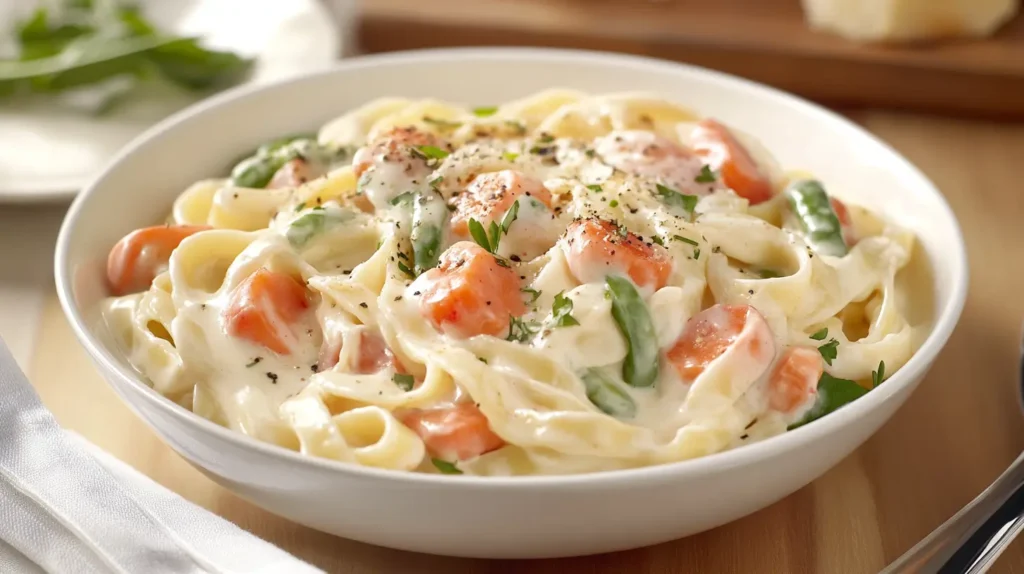
Expert Tips for Perfect Results
- Pasta water is gold:
- The starchy pasta water helps emulsify the sauce
- Always reserve more than you think you’ll need
- Cheese matters:
- Use authentic Parmigiano-Reggiano for best flavor
- Grate it fresh – pre-shredded won’t melt as smoothly
- Don’t overcrowd the pan:
- Cook vegetables in batches if necessary
- They should sauté, not steam
- Temperature control:
- Keep sauce at a gentle simmer
- High heat can cause separation
- Timing is everything:
- Have all ingredients prepped before starting
- The dish comes together quickly once you begin cooking
Serving Suggestions for Spring Vegetable Fettuccine Alfredo
Presentation elevates this dish from everyday to extraordinary:
- Plating:
- Use warm, shallow bowls
- Twirl pasta with tongs for height
- Arrange some vegetables visibly on top
- Garnishes:
- Freshly grated Parmesan
- Chopped herbs (basil, parsley, or chives)
- Lemon zest for brightness
- Red pepper flakes for heat
- Side dishes:
- Garlic bread or crusty baguette
- Simple green salad with lemon vinaigrette
- Roasted artichokes
Nutritional Information for Spring Vegetable Fettuccine Alfredo
While this is an indulgent dish, the spring vegetables add valuable nutrients:
Per serving (serves 6):
- Calories: 580
- Protein: 18g
- Carbohydrates: 52g
- Fiber: 5g
- Healthy fats from olive oil and dairy
- Vitamins A, C, K from vegetables
- Calcium from Parmesan cheese
For a lighter version, see our variation suggestions below.
Variations & Customizations
This recipe serves as a wonderful template for creativity:
Protein Additions
- Grilled chicken: Add 2 cups shredded cooked chicken
- Shrimp: Sauté 1 lb peeled shrimp with garlic
- Pancetta: Crisp 4 oz diced pancetta as garnish
- White beans: Add 1 can drained cannellini beans
Vegetarian/Vegan Options
- Vegetarian: Use vegetable broth if needed
- Vegan:
- Substitute butter with olive oil
- Use cashew cream instead of dairy
- Nutritional yeast for cheesy flavor
Gluten-Free Adaptation
- Use gluten-free fettuccine
- Check that Parmesan is gluten-free (some brands use anti-caking agents)
Seasonal Twists
- Summer: Add roasted bell peppers and eggplant
- Fall: Incorporate roasted butternut squash
- Winter: Try with sautéed mushrooms and kale
Storage & Reheating Instructions
Refrigeration
- Store in airtight container for up to 3 days
- Separate sauce if possible (pasta absorbs liquid)
- Vegetables may soften but flavor remains good
Freezing
- Best without vegetables (they become mushy)
- Freeze sauce separately for up to 1 month
- Thaw overnight in refrigerator before reheating
Reheating
- Stovetop method:
- Use low heat
- Add splash of milk or cream
- Stir frequently
- Microwave method:
- Cover with damp paper towel
- Heat in 30-second intervals
- Stir between intervals
Troubleshooting Common Issues
Even experienced cooks encounter challenges:
- Sauce is too thick:
- Thin with warm milk or pasta water
- Add 1 tbsp at a time until desired consistency
- Sauce is too thin:
- Simmer gently to reduce
- Add more grated Parmesan
- Make a quick slurry with cornstarch if needed
- Sauce separates:
- Remove from heat immediately
- Whisk in 1 tbsp cold butter
- Add splash of hot water while whisking
- Vegetables are overcooked:
- Next time, blanch for less time
- Add them at the very end
- Consider roasting instead of blanching
FAQs About Spring Vegetable Fettuccine Alfredo
Can I make this dish ahead of time?
While best served fresh, you can prep components in advance:
- Blanch vegetables and store refrigerated
- Make sauce base (hold cheese until reheating)
- Cook pasta 80% done, then finish when ready
What’s the best substitute for heavy cream?
For a lighter version:
- Half-and-half works well
- Whole milk with 1 tbsp flour
- Evaporated milk provides richness
How do I prevent the pasta from sticking together?
- Use plenty of boiling water
- Stir frequently during first 2 minutes
- Toss with sauce immediately after draining
Can I use other pasta shapes?
Absolutely! Try:
- Pappardelle for extra sauce adherence
- Penne for easy serving
- Farfalle for visual appeal
Is there a way to make this dairy-free?
Yes, with these substitutions:
- Coconut milk or cashew cream for heavy cream
- Nutritional yeast for cheese flavor
- Olive oil instead of butter
Conclusion: A Dish for All Occasions
This Spring Vegetable Fettuccine Alfredo represents everything wonderful about seasonal cooking. It’s adaptable to what’s fresh and available, satisfying enough for comfort food cravings, yet bright and vibrant enough to celebrate spring’s arrival. The creamy sauce clings perfectly to each strand of pasta, while the vegetables add pops of color, texture, and nutrition.
What makes this recipe truly special is its versatility. It’s elegant enough for date night, easy enough for busy weeknights, and impressive enough for dinner parties. The variations allow you to make it your own, adapting to dietary needs or simply using what you have on hand.
As spring progresses, try experimenting with different vegetable combinations – perhaps adding ramps when they’re in season, or swapping in fresh fava beans when available. Each variation will give you a slightly different but equally delicious result.
We’d love to hear how you make this dish your own! What seasonal vegetables did you use? Did you add any special touches? Share your experiences in the comments below. Happy cooking!
For more creative ideas, check out this Lemon Tart in Just 4 Simple Steps.
There are no reviews yet. Be the first one to write one.

